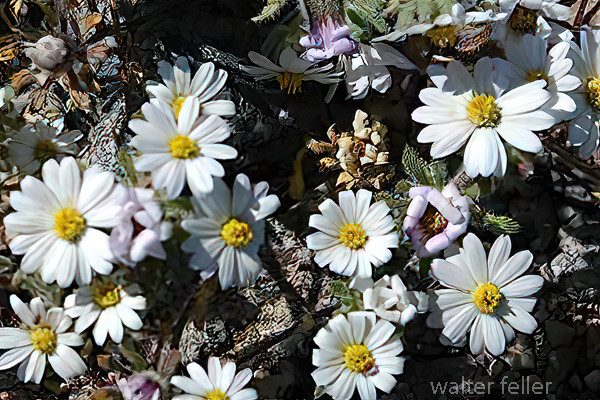Desert Star
Monoptilon bellioides
Desert Star is a tiny but brilliant wildflower that appears in the early spring desert bloom, often carpeting the ground with starry white flowers. It’s one of the smallest and most delicate wildflowers in the Mojave and Sonoran Deserts.
Appearance:
A low-growing annual, usually only 1 to 3 inches tall. It forms a small, almost invisible tuft of fine leaves, from which bright white daisy-like flowers emerge. The flower heads are typically about the size of a dime, with yellow centers and white rays that give the plant its “star” name.
Habitat:
Found in sandy desert flats, washes, and gentle slopes. Prefers open, well-drained soils in full sun.
Bloom Time:
Blooms from February to April, shortly after winter rains.
Pollinators:
Attracts tiny bees and flies. Even though it’s small, it plays an important role in the desert's pollinator network.
Note:
Desert Star is easy to miss when not in bloom, but once it flowers, it creates a stunning effect—like the desert floor has been sprinkled with white stars. A favorite among wildflower watchers for its simplicity and charm.
Monoptilon bellioides, the desert star, also called Mojave desertstar, is a desert flowering plant in the family Asteraceae. It is native to stony and sandy plains in the Mojave Desert of California and the Sonoran Deserts of the Southwestern United States northwestern Mexico. It is and is very common in the northern, eastern, and southern parts of the desert.
It is native to stony and sandy plains in the Mojave Desert of California and the Sonoran Deserts of the Southwestern United States northwestern Mexico.
It is and is very common in the northern, eastern, and southern parts of the desert.
Monoptilon bellioides is a short annual plant; in seasons with very little rainfall, the plant may only grow to 1-2 cm, if it grows at all, while in seasons of heavy rainfall, it can grow up to 25 cm tall. The leaves are linear, 5-10 mm long, with a blunt apex. The flowers are produced in dense inflorescences (capitula), 2 cm diameter, with white ray florets and yellow disc florets in the center. The flowers open in the morning and close in the evening.
Found in sandy desert areas, washes
Elevation: 200–1200 m. (650-4000 ft.)
Flowering time: Feb–May, Sep.
Annual: 2-25 cm. tall.
2 cm diameter, with white rays and yellow disc in the center. The flowers open in the morning and close in the evening.
Calscape